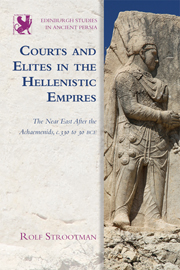Book contents
- Frontmatter
- Contents
- List of Illustrations
- Acknowledgements
- Abbreviations
- The Hellenistic Dynasties
- Series Editor's Preface
- Map
- Introduction: Court and Empire in the Hellenistic Near East
- PART I SETTING THE SCENE
- PART II THE COURT AS A SOCIO-POLITICAL SYSTEM
- 4 The Royal Household
- 5 Court Society
- 6 Royal Pages
- 7 Social Dynamics
- 8 Hierarchy and Conflict
- PART III CEREMONIAL AND RITUAL
- Conclusion
- Bibliography
- Index
4 - The Royal Household
from PART II - THE COURT AS A SOCIO-POLITICAL SYSTEM
Published online by Cambridge University Press: 05 September 2014
- Frontmatter
- Contents
- List of Illustrations
- Acknowledgements
- Abbreviations
- The Hellenistic Dynasties
- Series Editor's Preface
- Map
- Introduction: Court and Empire in the Hellenistic Near East
- PART I SETTING THE SCENE
- PART II THE COURT AS A SOCIO-POLITICAL SYSTEM
- 4 The Royal Household
- 5 Court Society
- 6 Royal Pages
- 7 Social Dynamics
- 8 Hierarchy and Conflict
- PART III CEREMONIAL AND RITUAL
- Conclusion
- Bibliography
- Index
Summary
Viewed from the outside, the royal household presented an image of unity and harmony. Courtiers found it advantageous to keep up a façade of mutual agreement and of their compliance with the king's absolute power. In practice, however, the unity of the court was often disarrayed as a result of polygamous marriage and competition among the courtiers. At the Argead court, the core of the household was divided into sub-families centred on the respective queens and their children, all with their own followers and personal attendants. The Ptolemaic court was often broken into segments centred on various candidates for the throne, both male and female. As a result, conflict over the succession frequently broke out, often with disastrous effects. In the Seleukid empire, there could be two or three courts at the same time in various places within the gigantic realm: always one around the king, often one around his heir and co-ruler (who also carried the title of basileus), and sometimes one around the principal queen and mother of the heir. Relations between the philoi and the king, and among philoi, were not always harmonious. The reigning king was not automatically the most powerful individual. Conflicts among courtiers were common. In order to remain masters of their own houses, kings often employed ‘favourites’ to counterbalance the power of the philoi.
- Type
- Chapter
- Information
- Courts and Elites in the Hellenistic EmpiresThe Near East After the Achaemenids, c. 330 to 30 BCE, pp. 93 - 110Publisher: Edinburgh University PressPrint publication year: 2014



